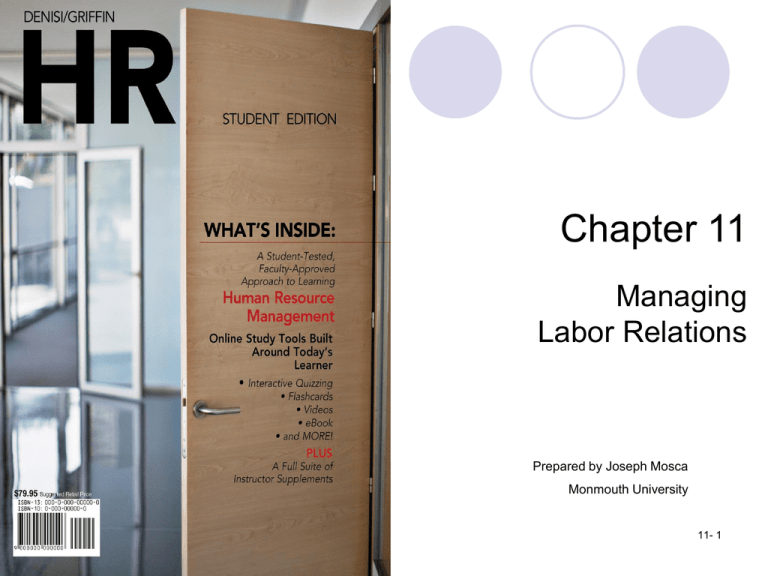
Chapter 11
Managing
Labor Relations
Prepared by Joseph Mosca
Monmouth University
Copyright ©2012 by Cengage Learning. All rights reserved.
11- 1
Learning Objectives
1. Describe the role of labor unions in
organizations.
2. Identify and summarize trends in unionization.
3. Discuss the unionization process.
4. Describe the collective-bargaining process.
5. Discuss how labor agreements are negotiated.
6. Describe how impasses get resolved and
agreements are administered.
7. Discuss emerging labor issues in the twenty-first
century.
Copyright ©2012 by Cengage Learning. All rights reserved.
11- 2
The Role of Labor Unions in
Organizations
Labor relations is the
process of dealing with
employees who are
represented by a union.
A labor union is a
legally constituted
group of individuals
working together to
achieve shared, jobrelated goals, including
higher pay and shorter
working hours.
Copyright ©2012 by Cengage Learning. All rights reserved.
11- 3
What is Collective Bargaining?
It is the process by
which managers and
union leaders
negotiate acceptable
terms and conditions
of employment for
those workers
represented by the
unions.
Copyright ©2012 by Cengage Learning. All rights reserved.
11- 4
Historical Development of Unions
The Knights of Labor was an important early
union that expanded its goals and its
membership to include workers in numerous
fields rather than a single industry.
The American Federation of Labor (AF of L)
was another early union. It focused its efforts
on improved working conditions and better
employment contracts rather than getting
involved in legislative and political activities.
Copyright ©2012 by Cengage Learning. All rights reserved.
11- 5
Legal Context of Unions
The National Labor Relations Act,
passed in 1935 and more commonly
referred to as the Wagner Act, granted
power to labor unions on a footing more
equal with managers in terms of the rights
of employees.
The National Labor Relations Board
(NLRB) administers most labor laws in the
United States.
Copyright ©2012 by Cengage Learning. All rights reserved.
11- 6
Legal Context of Unions (cont’d)
A union shop agreement includes various
types of union security agreements in
addition to a requirement that a nonunion
member can be hired, but he or she must join
the union within a specified time to keep his
or her job.
The Landrum-Griffin Act (officially called
the Labor Management Reporting and
Disclosure Act) was passed in 1959 and
focused on eliminating various unethical,
illegal, and undemocratic union practices.
Copyright ©2012 by Cengage Learning. All rights reserved.
11- 7
Union Structures
Locals are unions organized at the level of
a single company, plant, or small geographic
region.
The shop steward, an elected position in a
local union, is a regular employee who
functions as a liaison between union
members and supervisors.
Copyright ©2012 by Cengage Learning. All rights reserved.
11- 8
Setting Parameters for Collective
Bargaining
Copyright ©2012 by Cengage Learning. All rights reserved.
Mandatory items,
including wages,
working hours, and
benefits, must be
included if either party
expresses a desire to
negotiate one or more
items.
Permissive items
may be included if both
parties agree.
11- 9
Barriers to Effective Negotiations (con’t)
A strike occurs when
employees walk off their jobs
and refuse to work.
Picketing occurs when
workers representing the
union march at the entrance
to the employer’s facility with
signs explaining their reasons
for striking.
A boycott occurs when union
members agree not to buy
the products of a targeted
employer.
Copyright ©2012 by Cengage Learning. All rights reserved.
11- 10
Barriers to Effective Negotiations (con’t)
A slowdown occurs when
workers perform their jobs at a
much slower pace than normal.
A wildcat strike occurs during
the course of a labor contract
and is usually undertaken in
response to a perceived
injustice on the part of
management.
A lockout occurs when an
employer denies employees
access to the workplace.
Copyright ©2012 by Cengage Learning. All rights reserved.
11- 11
Resolving Impasses (cont’d)
In arbitration both sides
agree in advance that
they will accept the
recommendations made
by an independent third
party.
Under final-offer
arbitration, the parties
bargain until impasse
and then the two parties’
final offers are submitted
to the arbitrator.
Copyright ©2012 by Cengage Learning. All rights reserved.
11- 12
“Replacement” Sources of Labor
Both unions and employers are becoming
involved in the hiring of prisoners and
paying them the rate of the minimum
wage.
Copyright ©2012 by Cengage Learning. All rights reserved.
11- 13
Unions and the Electronic Age
The internet presents many interesting
problems for labor unions, such as:
Computers and technology mean that work can
be done by fewer employees.
Unions have no input when organizations move
operations to foreign lands for cheaper labor
costs.
Technology often reduces the number of
employees required to work.
Copyright ©2012 by Cengage Learning. All rights reserved.
11- 14
How Has Technology Been Positive for
Unions?
Unions can
communicate more
easily with members.
Prospective members
are easily reached in
spite of no-solicitation
rules.
Copyright ©2012 by Cengage Learning. All rights reserved.
11- 15





